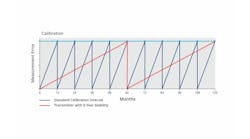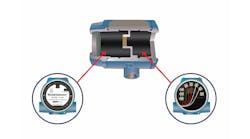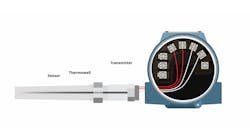Greg McMillan ([email protected]) and Stan Weiner, PE, bring their wit and more than 66 years of process control experience to bear on your questions, comments, and problems.
Greg: The May puzzler "Hair-Trigger Temperature Loops" was a bit hairy. I was concerned no one would be able to solve it, but Hunter Vegas came through and wins a free copy of A Funny Thing Happened on the Way to the Control Room for sending in the first good answer. The puzzler concerned a noble but misguided attempt to reduce loop dead time by decreasing temperature loop scan time and moving temperature measurement locations closer to the feed.
Hunter: There are probably two issues at work here. First, some controller's tuning constants (especially derivative) are affected by scan times. When the scan times were changed, the tuning constants were changed as well. The second issue is the new location of the temperature sensors. Typically the plant is trying to control the temperature of the vessel. If the sensor is too close to the feed, it measures the feed temperature and not the vessel temperature, so tight control would be impossible.
Stan: A decrease in loop scan time decreases the signal-to-noise ratio. Temperature rarely changes faster than 0.25[DEG] per minute in a vessel or column. Thus, it takes at least about 10 seconds to exceed the DCS A/D resolution of 0.05% for a 100 [DEG] span. Faster scan times show mostly A/D noise triggered by ever-so-tiny amounts of sensor thermal and electrical noise.
Greg: The derivative of the A/D step is a nasty pulse even with the built-in rate limiting filter. The derivative action has to be cut back severely to avoid wearing out the valve, spreading the upset to other loops, and testing your manager's good will. The process and sensor with its many secondary thermal lags and your career with its inertia that would have so nicely benefited from derivative action is left to go off in unanticipated and unappreciated directions.
Stan: Hunter correctly surmised you really want to measure the vessel temperature and not the feed temperature. In fact, a location of the sensor in the vessel near dip tubes or feed nozzles causes an intermittent measurement of the vessel and feed temperatures, which adds more noise that is amplified by derivative action.
Greg: For columns, the best tray for measurement and control is the one with the largest response in both directions for a change in the controller output. If by some fluke this works out to be the feed tray, the next tray above is best for the manipulation of reflux or distillate flow and the next tray below is the choice for the manipulation of steam or bottoms flow.
Stan: All this control talk harks back to the days when we lived and breathed process control.
Greg: I had a touch of nostalgia recently at a Joe Cocker concert. It brought back memories of how I learned the fundamentals of process control at purple passion parties.
Stan: I vaguely remember tubs of grain alcohol and grape juice.
Greg: The time from your first drink till when you first started to feel good was dead time. If you had no anticipation of where your head was headed based on the rate of change of exhilaration (no derivative action) and didn't stop drinking, you were into an exponential response and prone to end up prone in some strange place. In fact, you might exhibit an accelerating or runaway response before the crash if an increase in intoxication decreases your sense of sensibility for intake rate. The occasion was often marked by incredible insights, none of which fortunately you will remember. Now, if you had model predictive control (MPC) instead of just PID control, you would know your time to adequate inebriation from your sequence of drinks, and perhaps you'd stop at the optimum number. Of course, an MPC requires an experimental model and hence extensive testing. What I did in the name of furthering my understanding of control in a purple haze or daze or craze was beyond understanding and has made me what I am today, a person who can match wits with Ozzy Osborne any day of the week.
Stan: Even better than an MPC with its blind assumptions would be an online property estimator that would provide an instantaneous prediction of the peak alcohol concentration in your blood stream based on your weight, last meal, time series of drinks, and concentration in the tub.
Greg: To continue down this path of enlightenment, each month I will include a select number of questions from the Purple Reign era with the answers at the end so tiny, you will see what it is like to be as old as me and Stan.
Questions from the Purple Reign
1. You need to increase production rate, but the operator says the feed setpoint is the highest it can go. Should you:
A. Tell your boss it is not possible
B. Slowly increment the feed and look for problems
C. Solve the differential equations for the new setpoint
D. Say "I smell food burning" and increase the setpoint when the operator dashes for the kitchen
2. To improve control system performance, the first thing you should do is:
A. Install a business tactical scheduler
B. Add real-time optimization
C. Install an expert system
D. Fix the measurements and valves and tune the loops
3. The optimum operating point is the:
A. Operator's sweet spot
B. Easiest operating point
C. Setpoint with the fewest war stories
D. Setpoint based on plant tests
4. The most common constraint to better process efficiency is the:
A. Operator
B. Measurement offset
C. Valve linearity
D. Business model
Stan: Even more mystifying than that selection of questions is this month's puzzler. The RTD sensors during a project's construction phase were dutifully removed from the thermowells before sand blasting the new lines. Why did the temperature loops develop a slow roll during startup?
Greg: Now for this month's disclaimer. The authors are developing dynamic models and online property estimators for wineries that will require intensive and extensive validation.
Answers: B, D, D, A
This Month's Puzzler:
Blast Those RTDs!
During project construction, the RTD sensors are dutifully removed from the thermowells before sand blasting the new lines. Why did the temperature loops develop a slow roll during startup?



